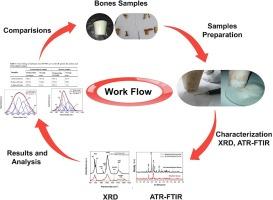Ancient and modern bone diagnosis: Towards a better understanding of chemical and structural feature alterations
IF 4.3
2区 化学
Q1 SPECTROSCOPY
Spectrochimica Acta Part A: Molecular and Biomolecular Spectroscopy
Pub Date : 2024-10-10
DOI:10.1016/j.saa.2024.125259
引用次数: 0
Abstract
Chemical and structural alterations hold great importance in the field of diagenesis. Attenuated Total Reflectance − Fourier Transform Infrared Spectroscopy (ATR-FTIR) is a valuable method for examining bio-apatite composition changes. Infrared spectroscopy (IR) and X-ray diffraction (XRD) were employed to analyze both modern and archaeological bone specimens. Organic and mineral component changes in modern and ancient samples were investigated. Ancient bone samples were collected from two archaeological sites in Jordan, dating back to the Iron and Byzantine ages. IR results indicated that collagen cross-links and mineral maturity are higher in modern bones compared to ancient bones. Additionally, the crystallinity index is higher in modern bones than in archaeological bones, while the carbonate to phosphate ratio (C/P) is lower in modern bones than in ancient ones. Curve fitting was applied to reveal the carbonate substitution inside the hydroxyapatite lattice within the IR region from 850 to 890 cm−1. A2-type carbonates (identified as υ2 of CO32−) denote hydroxyl site substitution, and B-type carbonates represent a substitution to the phosphate site. The full width at half maximum (FWHM) of the peak at 604 cm−1 from IR spectra reveals that crystallinity is higher in modern bones, as confirmed by the FWHM of the (002)-apatite pattern in XRD. Statistical analysis was conducted to validate these findings, ensuring the robustness of the results. Finally, the results obtained in this investigation align with previous literature reports regarding ATR-FTIR ratios. This suggests that modern bones have better crystallinity compared to ancient bones. Furthermore, the ATR-FTIR ratios indicate that the hydroxyl and phosphate sites of modern bones undergo more substitution than older bones. The findings of this study not only enhance our understanding of the diagnostic processes in archaeological bone specimens but also have broader implications for fields such as archaeology, anthropology, and forensics, where the analysis of bone composition and structural changes can provide valuable insights into the history and characteristics of ancient remains.

古代和现代骨骼诊断:更好地理解化学和结构特征的改变
化学和结构变化在成岩作用领域具有重要意义。衰减全反射-傅立叶变换红外光谱(ATR-FTIR)是研究生物磷灰石成分变化的重要方法。红外光谱(IR)和 X 射线衍射(XRD)被用来分析现代和考古骨标本。研究了现代和古代样本中有机成分和矿物成分的变化。古代骨骼样本采集自约旦的两个考古遗址,可追溯到铁器时代和拜占庭时代。红外光谱结果表明,与古代骨骼相比,现代骨骼中的胶原交联和矿物成熟度更高。此外,现代骨骼的结晶度指数高于考古骨骼,而现代骨骼的碳酸盐与磷酸盐比率(C/P)低于古代骨骼。曲线拟合揭示了羟基磷灰石晶格中 850 至 890 cm-1 红外区域内的碳酸盐替代情况。A2 型碳酸盐(被识别为 CO32- 的 υ2)表示羟基位点取代,B 型碳酸盐表示磷酸位点取代。红外光谱中 604 cm-1 处峰值的半最大值全宽(FWHM)显示,现代骨骼的结晶度更高,XRD 中 (002)-apatite 图样的半最大值全宽也证实了这一点。为验证这些发现,还进行了统计分析,以确保结果的稳健性。最后,本研究获得的结果与之前有关 ATR-FTIR 比率的文献报道一致。这表明,与古代骨骼相比,现代骨骼的结晶度更高。此外,ATR-FTIR 比值表明,现代骨骼的羟基和磷酸盐位点比古老骨骼发生了更多的置换。这项研究的发现不仅加深了我们对考古骨骼标本诊断过程的理解,而且对考古学、人类学和法医学等领域具有更广泛的意义,因为对骨骼成分和结构变化的分析可以为了解古代遗骸的历史和特征提供宝贵的信息。
本文章由计算机程序翻译,如有差异,请以英文原文为准。
求助全文
约1分钟内获得全文
求助全文
来源期刊
CiteScore
8.40
自引率
11.40%
发文量
1364
审稿时长
40 days
期刊介绍:
Spectrochimica Acta, Part A: Molecular and Biomolecular Spectroscopy (SAA) is an interdisciplinary journal which spans from basic to applied aspects of optical spectroscopy in chemistry, medicine, biology, and materials science.
The journal publishes original scientific papers that feature high-quality spectroscopic data and analysis. From the broad range of optical spectroscopies, the emphasis is on electronic, vibrational or rotational spectra of molecules, rather than on spectroscopy based on magnetic moments.
Criteria for publication in SAA are novelty, uniqueness, and outstanding quality. Routine applications of spectroscopic techniques and computational methods are not appropriate.
Topics of particular interest of Spectrochimica Acta Part A include, but are not limited to:
Spectroscopy and dynamics of bioanalytical, biomedical, environmental, and atmospheric sciences,
Novel experimental techniques or instrumentation for molecular spectroscopy,
Novel theoretical and computational methods,
Novel applications in photochemistry and photobiology,
Novel interpretational approaches as well as advances in data analysis based on electronic or vibrational spectroscopy.

 求助内容:
求助内容: 应助结果提醒方式:
应助结果提醒方式:


